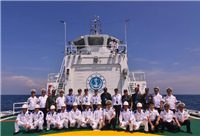

BEIJING, March 6 -- Economic growth in China may be slowing but the world's second largest economy is sanguine about growth stability and prospective improvements.
Moving away from the double-digit growth of the most recent decade, the economy has been facing notable downward pressure and has entered a stage known as the new normal, characterized by slow, but higher quality growth.
The economy posted 7.4 percent growth in 2014, its weakest since 1990 amid weaknesses in investment, consumption and overcapacity. The annual growth target was lowered to around 7 percent for 2015.
However, as a developing country, Chinese authorities have faith in the country's growth potentials.
Chinese Premier Li Keqiang said that he was "fully confident" of the economy.
"Our country's development has enormous potential and is hugely resilient, with ample room for growth," Li said during his delivery of a government work report to the annual session of the National People's Congress (NPC), which convened on Thursday.
Braving the new normal
Many entrepreneurs are playing down the challenges of the new normal. Qian Yuebao, chairwoman of Jiangsu Menglan Group Co. Ltd., which provides bedding products, is calm about the economic slowdown.
"Cheap labor and intensive use of resources are not sustainable. We knew that many years ago," said Qian, who is also an NPC deputy.
Refusing to settle on low-end manufacturing, more than 10 years ago the company expanded investment to cover research and introduced advanced equipment to establish itself at home and abroad.
The business woman said that even in 2008 when the global financial crisis wreaked havoc, exports increased more than 20 percent year on year while many of her competitors suffered.
She said that equipment imported from Germany, Spain and Switzerland slashed labor costs by 80 percent.
The company's success epitomizes the success of the innovation and upgrading drive in Jiangsu Province. The provincial GDP expanded 8.7 percent in 2014, out-pacing national GDP growth.
"Jiangsu Province has topped regional innovation rankings for six years in a row due to science and technology advances," Provincial Governor Li Xueyong said.
High-tech firms in the province accounted for almost 40 percent of industrial output last year, following an influx of talent and skilled workers, he said.
Technological upgrade is the way forward for Chinese enterprises trying to find their way amid the new normal. The sooner upgrades happen, the better for business, NPC deputies agreed.
Chinese President Xi Jinping on Thursday called for a quicker roll-out of free trade zone strategy to spearhead reforms, opening-up, and the innovation drive, saying that innovation was the most important driver of development.
7 PCT growth target achievable
Premier Li Keqiang stressed that China must keep a steady growth rate to ensure employment and income continue to increase.
Li hailed mass entrepreneurship, and increased public goods and services provision as the two new engines of growth.
"For the former, the main role for the government will be to provide a conducive environment and lower entry barriers. For the latter, the government will not only increase spending but also invite corporate sector participation," said Wang Tao, chief China economist with UBS.
Zhang Xiaoji, a researcher at the Development Research Center of the State Council, said that a 7 percent growth target would be a challenge given government pressure on pollution and emission control.
"However, I think China is likely to realize a growth speed of around 7 percent," said Zhang.
The road and belt initiatives as well as China's free trade arrangements with other countries will also help manufacturing exports, said Zhang, who is also a member of the National Committee of Chinese People's Political Consultative Conference (CPPCC), China's top political advisory body.
Justin Yifu Lin, former chief economist and senior vice president of the World Bank, said on Friday that China still had great economic development potential in many industries and could beat the growth target of around 7 percent this year.
Lin's optimism is fueled by sectors like equipment manufacturing, e-commerce, Internet finance, new energy and environmental protection, which he says have growth potential.
Mei Xingbao, also a CPPCC member, predicts that a growth rate of 7 percent is possible thanks to the ongoing reform drive which will continue to unleash momentum, encourage private capital investment, and lift consumption.
"The government does not want to undershoot the growth target this year given the government work report explicitly mentioned the importance of a stable growth to support new job creation and ensure stable employment condition," J.P. Morgan China chief economist Zhu Haibin said in a research note.
Zhu said even though the government had reiterated a prudent monetary policy for this year, some flexibility was expected. "The prudent monetary policy is favorable toward easing," he said.
Zhu predicted the central bank will cut reserve requirement ratio (RRR) again in the second quarter.
To offset the slowdown, the central bank has cut the benchmark interest rates twice and dropped the RRR for banks over the past four months.
 China hosts overseas disaster relief exercise for the first time
China hosts overseas disaster relief exercise for the first time 20 pairs of twins who will become flight attendants in Sichuan
20 pairs of twins who will become flight attendants in Sichuan J-11 fighters in air exercise
J-11 fighters in air exercise PLA soldiers operating vehicle-mounted guns in drill
PLA soldiers operating vehicle-mounted guns in drill Beauties dancing on the rings
Beauties dancing on the rings Blind carpenter in E China's Jiangxi
Blind carpenter in E China's Jiangxi Top 10 highest-paid sports teams in the world
Top 10 highest-paid sports teams in the world In photos: China's WZ-10 armed helicopters
In photos: China's WZ-10 armed helicopters UFO spotted in several places in China
UFO spotted in several places in China Obama is sowing discontent in S.China Sea
Obama is sowing discontent in S.China Sea Rescuers work through night to reach cruise ship survivors
Rescuers work through night to reach cruise ship survivors Driving through limbo
Driving through limbo Facing down MERS
Facing down MERSDay|Week